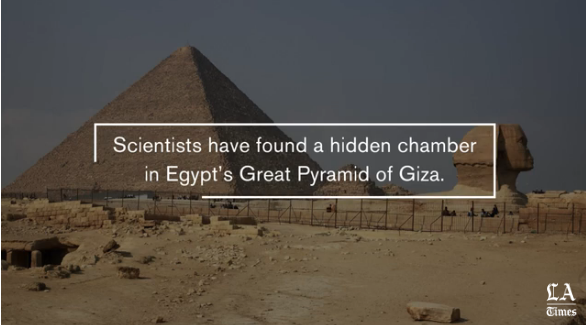
http://www.latimes.com/science/sciencenow/la-sci-egypt-pyramid-giza-20171102-story.html
latimes.com
Scientists have found a hidden chamber in Egypt’s Great Pyramid of Giza, the first such discovery in the structure since the 19th century and likely to spark a new surge of interest in the pharaohs.
In an article published on Thursday, an international team said the approximately 30-yard void deep within the pyramid is situated above the structure’s Grand Gallery, and it also has a similar cross section. The purpose of the chamber is not fully clear, and it’s yet unknown whether it was built with a function in mind or not.
The scientists made the discovery using cosmic-ray imaging, recording the behavior of subatomic particles called muons that penetrate the rock. Their paper was peer-reviewed before appearing in Nature, an international, interdisciplinary journal of science.
The pyramid is also known as Khufu’s Pyramid for its builder, a 4th Dynasty pharaoh who reigned from 2509 to 2483 B.C. Visitors to the pyramid, on the outskirts of Cairo, can walk, hunched over, up a long tunnel to reach the Grand Gallery. The newly discovered chamber does not appear to be connected to any known internal passages.
Scientists involved in the scanning called the find a “breakthrough” that highlighted the usefulness of modern particle physics in archaeology.
“This is a premier,” said Mehdi Tayoubi, a co-founder of the ScanPyramids project and president of the Heritage Innovation Preservation Institute. “It could be composed of one or several structures ... maybe it could be another Grand Gallery. It could be a chamber, it could be a lot of things.”
“It was hidden, I think, since the construction of the pyramid,” he added.
The pyramids at Giza, the last surviving wonder of the ancient world, have captivated visitors since they were built as royal burial chambers 2,500 years ago. Experts are still divided over how they were constructed, so even relatively minor discoveries generate great interest.
Late last year, for example, thermal scanning identified a major anomaly in the Great Pyramid — three adjacent stones at its base which registered higher temperatures than others, stoking imaginations worldwide.
Speculation that King Tutankhamun’s tomb also contains additional antechambers stoked interest in recent years, before scans by ground-penetrating radar and other tools came up empty, raising doubts about the claim.
The muon scan is accomplished by planting special plates inside and around the pyramid to collect data on the particles, which rain down from the Earth’s atmosphere. They pass through empty spaces but can be absorbed or deflected by harder surfaces, allowing scientists to study their trajectories and discern what is stone and what is not. Several plates were used to triangulate the void in the Great Pyramid.
Tayoubi said the team plans to work with others to come up with hypotheses about the new discovered area.
“The good news is that the void is there, and it’s very big,” he said.
Copying/Pasting full texts without adding anything original is frowned upon by the community.
Some tips to share content and add value:
Repeated copy/paste posts could be considered spam. Spam is discouraged by the community, and may result in action from the cheetah bot.
If you are actually the original author, please do reply to let us know!
Thank You!
More Info: Abuse Guide - 2017.
vai eto onnoti kobe hoilo??
eito vai apnader doway..